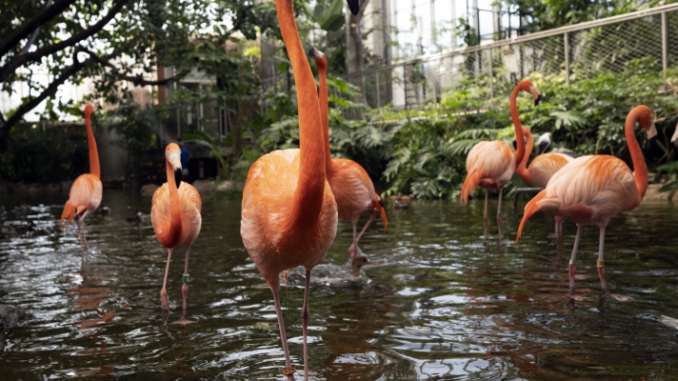
Emily Fritz | A&E Editor
Laughter accompanied the honking coming from the “Wetlands” of the National Aviary on Saturday as guests from all over came to see the American flamingos. Rizzo, one of the social scarlets in the flock, hung by the visitor railing to show off his pretty-in-pink wings and “flamingle” with his new friends.
Last weekend the National Aviary held their annual “Flamingo Fest,” complete with brightly feathered flamboyance, educational opportunities for guests of all ages and valentine-themed enrichment activities for their other winged residents.
“[Flamingo Fest] is our most popular weekend event by far. It is attended by flamingo fans, bird fans, pink fans, just general aviary fans, and they get very excited,” said digital marketing specialist Britta Moletz. “And it is a great way for us to raise awareness for our animal conservation efforts and the work we do every single day at the National Aviary.”
The day was chock-full of different activities, like “Flamingo Talk,” which took place in the Wetlands wing of the aviary. Here, visitors learned more about common flamingo myths, their usual diets, natural habitat and breeding behaviors.
The vibrant feathers that we are used to seeing are actually caused by a flamingo’s diet – microscopic shrimp and algae. At birth, the bird has white-gray feathers but the deep scarlet and pink pigmentation in their plumage is a tell-tale sign of their nutritious diets during development.
Similarly, flamingos are well-known for standing on one leg, with one “knee” bent backwards. In reality, many birds stand on one leg, but the flamingo’s long legs make their balancing act better known.
“It may look like their leg is bending backwards, but they are actually bending their ankle! A flamingo’s knee is higher up on the leg, close to the body,” the National Aviary’s website said.
In addition to the mini seminar on flamingos, guests could create a flamingo sun catcher craft, learn new bio-facts, participate in kid-friendly, flamingo-inspired yoga and complete interactive activities, which focused on the filter system that flamingos possess in their bills.
The nonprofit’s regularly scheduled events sold out due to the increase in attendance for the flamingo-themed festivities.
“All of our animal encounters, which allow you to get closer to certain species like the Linnaeus two-toed sloth and African penguin … were all sold out way ahead of time. Our Rainbow lorikeet feedings sold out. Our 11 a.m. ‘Habitat Heroes’ [show] was sold out,” Moletz said.
Using the bright pink bird as the focal point of “Flamingo Fest” allowed the National Aviary to attract guests and expose them to more members of the bird world.
“Once you can get that person through the door and make a connection with a bird like a flamingo, it becomes so much easier to make a connection with a small bird like an owl finch, which most people probably have never even heard of,” said Christa Gaus, Senior Manager of Animal Programs.
With the help of the National Aviary and other Association of Zoos & Aquariums (AZA) accredited institutions, the Guam rail, a small flightless bird, has been hatched and reintroduced to the wild, going from ‘extinct in the wild’ to ‘critically endangered,’ a huge feat for the species. Similarly, the Guam kingfisher bird, which is currently ‘extinct in the wild’ is on a path to recovery with the National Aviary.
“It is up to AZA accredited facilities to build that population and then eventually, hopefully reintroduce them into the wild and build a new population,” Gaus said.
“Using a flamingo to get them in and then to teach that additional conservation messaging is really key,” Moletz said.
In addition to their efforts to rebuild critically endangered species, the National Aviary provides the public with resources to create their own impactful changes.
The “Lights Out Pittsburgh Movement” encourages locals to turn off their non-essential lights from Sept. 1 to Nov. 15 during nighttime hours. Doing so assists with seasonal migration, preventing navigation disruptions for hundreds of thousands of birds.
For those looking for more involvement, the National Aviary has a rolling application for volunteers on their website, https://www.aviary.org/about-us/jobs/volunteer/. Students can also hone their skills by applying for an internship opportunity with the nonprofit, with applications open until Mar. 7.
Events similar to “Flamingo Fest” will be coming to the National Aviary in the coming months, with “Eggstravaganza” at the end of March and “Penguin Palooza” in April.
“The more awareness that we can raise about the big species,” Gaus said, “also allows us to raise awareness about those lesser known species as well.”

